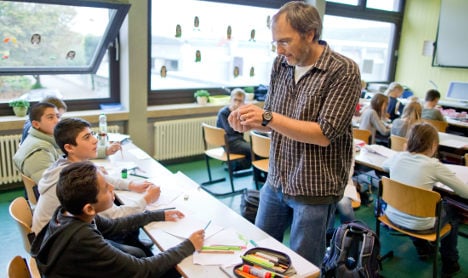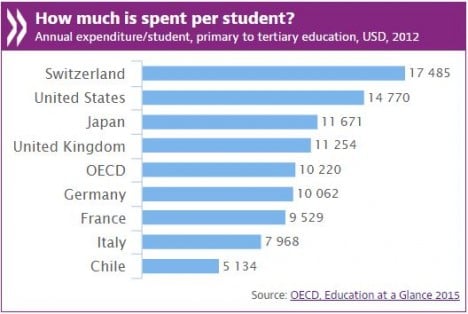5 ways German schools trump the US and UK

A new report reveals how Germany's education system stacks up against the United States and the UK - with good news for kids in the Federal Republic.
The Organisation for Economic Co-operation (OECD) released a detailed report on Tuesday, comparing educational systems of countries around the world.
Just because the grass always seems to be a bit greener on the other side, The Local took a look at ways the Germans tend to excel - and ways they fall behind.
1. Teachers’ pay
 Photo: DPA
Photo: DPA
Many in the United States grumble about teachers' being paid badly, and not without reason - US teachers are among the worst paid within the OECD relative to their qualifications.
But German teachers have one of the highest statutory salaries among OECD countries, with starting salaries for primary to upper secondary school teachers being second only to Luxembourg.
The average primary school teacher in Germany, for example, made the equivalent of $60,618 (€57,159) in 2013 while that number was $51,334 (€48,405) in the United States.
In England, the average salary was even lower - $42,399 (€39,980).
"Uncompetitive salaries will make it harder to attract the best candidates to the teaching profession, especially as the teaching workforce is ageing, with 35 percent of secondary school teachers at least 50 years old in 2013," the OECD report states.
2. Early childhood education
 Photo: DPA
Photo: DPA
Germans have taken early childhood education seriously for some time, as is shown in the country's "almost universal" programmes where 92 percent of three-year-olds are enrolled.
The United States does quite poorly in comparison - just 41 percent of three-year-olds are in educational programmes.
The UK does beat both, though, in this category, with 97 percent of children aged three in education.
Germany still out-spends the US and UK on pre-primary education as a percentage of its GDP.
3. Job placement after studies
 Photo: DPA
Photo: DPA
A smaller portion of the German population goes off to university than the OECD average, but this probably has to do with the country's system of vocational schooling. And even those in Germany without a university diploma have good chances of finding employment.
Nearly 90 percent of Germans with a university degree are employed, compared to the OECD average of 83 percent. And 78 percent of those with the equivalent of a high school education were employed, compared to the OECD average of 74 percent.
In the US, 80 percent of those with a bachelor’s degree were employed while 68 percent of those with a high school diploma had a job.
In the United Kingdom, 85 percent of bachelor’s degree recipients were employed, and 83 percent of those with the equivalent of a high school education were in work.
4. Smaller class sizes
 Photo: DPA
Not only do Germans make sure children get an early start on learning, but they also ensure that those tots get personal attention. On average, there are five students for each teacher in early education programmes.
In primary school, the average class size in German public schools is 21 students, while the average size in the UK is 27 and 22 in the US.
In public secondary schools, Germany has a student-to-teaching-staff ratio of 14, while that ratio is 24 in the UK and 16 in the US.
5. Science and engineering students
Photo: DPA
Not only do Germans make sure children get an early start on learning, but they also ensure that those tots get personal attention. On average, there are five students for each teacher in early education programmes.
In primary school, the average class size in German public schools is 21 students, while the average size in the UK is 27 and 22 in the US.
In public secondary schools, Germany has a student-to-teaching-staff ratio of 14, while that ratio is 24 in the UK and 16 in the US.
5. Science and engineering students
 Photo: DPA
Germany comes out on top for having the highest percentage of new bachelor's students in the fields of science and engineering - 40 percent.
In comparison, 31 percent of new bachelor's students in the UK were entering sciences or engineering.
The United States did not have data for this category of the report.
But...
Still, both the United States and the United Kingdom spend much more on each student than Germany does, and invest a greater portion of their respective GDPs on education.
The United States and the UK both spend more than six percent of their GDP and nearly 12 percent of public expenditures on education. Germany spends 4.4 percent of its GDP and less than ten percent of its public expenditure on education.
Photo: DPA
Germany comes out on top for having the highest percentage of new bachelor's students in the fields of science and engineering - 40 percent.
In comparison, 31 percent of new bachelor's students in the UK were entering sciences or engineering.
The United States did not have data for this category of the report.
But...
Still, both the United States and the United Kingdom spend much more on each student than Germany does, and invest a greater portion of their respective GDPs on education.
The United States and the UK both spend more than six percent of their GDP and nearly 12 percent of public expenditures on education. Germany spends 4.4 percent of its GDP and less than ten percent of its public expenditure on education.

Comments
See Also
The Organisation for Economic Co-operation (OECD) released a detailed report on Tuesday, comparing educational systems of countries around the world.
Just because the grass always seems to be a bit greener on the other side, The Local took a look at ways the Germans tend to excel - and ways they fall behind.
1. Teachers’ pay
 Photo: DPA
Photo: DPA
Many in the United States grumble about teachers' being paid badly, and not without reason - US teachers are among the worst paid within the OECD relative to their qualifications.
But German teachers have one of the highest statutory salaries among OECD countries, with starting salaries for primary to upper secondary school teachers being second only to Luxembourg.
The average primary school teacher in Germany, for example, made the equivalent of $60,618 (€57,159) in 2013 while that number was $51,334 (€48,405) in the United States.
In England, the average salary was even lower - $42,399 (€39,980).
"Uncompetitive salaries will make it harder to attract the best candidates to the teaching profession, especially as the teaching workforce is ageing, with 35 percent of secondary school teachers at least 50 years old in 2013," the OECD report states.
2. Early childhood education
 Photo: DPA
Photo: DPA
 Photo: DPA
Photo: DPA
A smaller portion of the German population goes off to university than the OECD average, but this probably has to do with the country's system of vocational schooling. And even those in Germany without a university diploma have good chances of finding employment.
Nearly 90 percent of Germans with a university degree are employed, compared to the OECD average of 83 percent. And 78 percent of those with the equivalent of a high school education were employed, compared to the OECD average of 74 percent.
In the US, 80 percent of those with a bachelor’s degree were employed while 68 percent of those with a high school diploma had a job.
In the United Kingdom, 85 percent of bachelor’s degree recipients were employed, and 83 percent of those with the equivalent of a high school education were in work.
 Photo: DPA
Photo: DPA Photo: DPA
Photo: DPA
Join the conversation in our comments section below. Share your own views and experience and if you have a question or suggestion for our journalists then email us at [email protected].
Please keep comments civil, constructive and on topic – and make sure to read our terms of use before getting involved.
Please log in here to leave a comment.